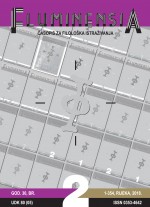INVENTORY OF THE MONASTERY OF ST. MARY MAGDALENE IN PORAT ON THE ISLAND OF KRK (1734 – 1878) AS A LINGUISTIC SOURCE: WRITING AND PHONOLOGY
Keywords:
glagolitic script, Glagolitic friars of the Franciscan Third Order Regular, pragmatic Glagolitic literacy, history of the Croatian language, Chakavian dialect, dialects of the island of KrkAbstract
The paper presents a review of the writing system and the orthographic and phonological features of the Inventory of St. Mary Magdalene in Porat on the island of Krk (1734–1878), a source representative of pragmatic Glagolitic literacy of the Franciscan Third Order Regular. The intention was to show that a text that seems to be scarce and monotonous can be a valuable source of dialectological material. The recorded phenomena were compared with the extant descriptions of the Krk dialects in literature: those of present-day dialects (Lukežić, Turk 1998) and of those that are almost contemporary to the respective source (Milčetić 1895). The general linguistic picture of the Inventory, especially its older part, shares traits with the immigrant dialects present on the island of Krk, slightly marked by the administrative style. On the phonological level the picture that the Inventory provides is, however, not consistent. This refers to the reflexes of the phoneme yat, to the vowels accompanying the syllabic r, and to the group cr / čr. Although we would expect that these innovations were introduced by the speakers of dialects which contain these traits, recently published historical sources containing information on the origin of monastic members do not support this assumption. The identified variations in writing are more of a reflection of the lack of uniformity in writing, of looser norm and doubts, than of actual language differences. Some writing solutions which are barely known in other Glagolitic texts (marking of palatality and the phoneme j with a mark similar to the apostrophe above the respective or preceding grapheme) and indications of modern orthography (capital letters and punctuation marks) must also be emphasized.

